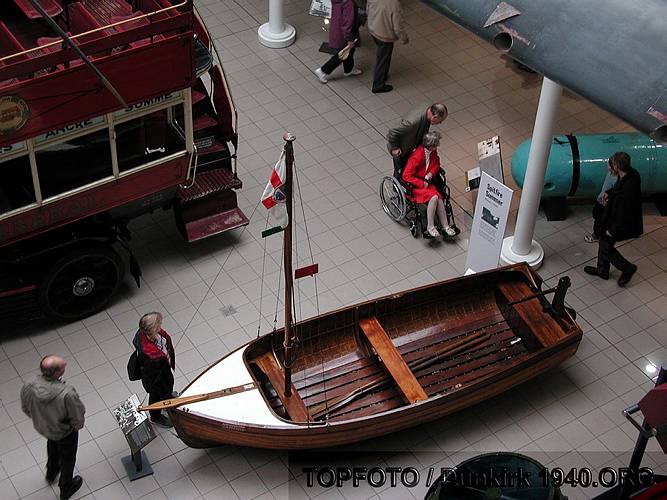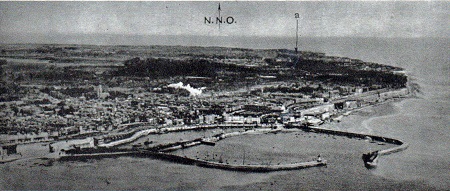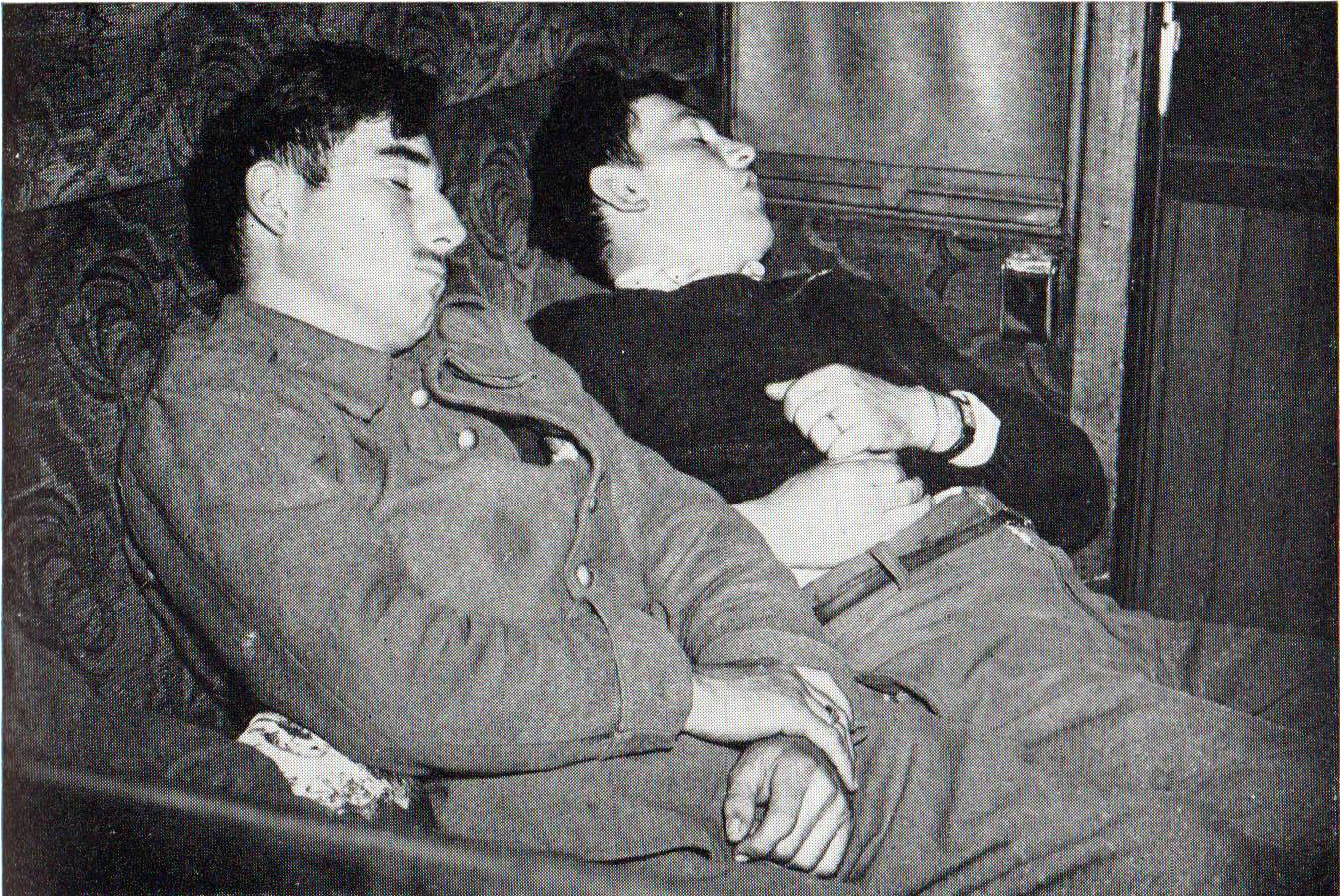 In May 1940, this one-time seaside resort was semi-deserted with less than half of its pre-war population still living in the town. However, on the other side of the Straits of Dover, dramatic events were unfolding which were to bring Ramsgate to the fore.
In May 1940, this one-time seaside resort was semi-deserted with less than half of its pre-war population still living in the town. However, on the other side of the Straits of Dover, dramatic events were unfolding which were to bring Ramsgate to the fore.As it became clear that evacuation of the British Expeditionary Force was inevitable, it was equally obvious that all the major ports in East Kent would be required to support an operation of this scale.

1930's aerial photograph of Ramsgate, used by the German Luftwaffe.
Early on in the planning of Operation Dynamo, it was appreciated that there was an urgent need to assemble a fleet of small boats capable of operating close to the shoreline of the gently shelving beaches at Dunkirk. Ramsgate was chosen as the final assembly point for these 'little ships' and for the organising of convoys. It was an obvious choice given Ramsgate's large sheltered harbour, marine engineering facilities, its rail links and its geographical proximity to Dunkirk. There was also a small Royal Navy shore base, HMS Fervent, based in tunnels and buildings on the former 'Merrie England' amusement arcade. However, the resources of HMS Fervent were to prove completely inadequate for what was about to unfold.

'Tamzine', the smallest survivor of the Dunkirk Little Ships.
It took time to assemble the fleet of little ships, and in the first few days of the operation there was a sporadic flow of ships and boats putting into Ramsgate to unload BEF troops. On the night of the 29th/ 30th May the first organised convoys of little ships departed from Ramsgate. Eight launches, together with their escorting motor boat 'Triton', left Ramsgate at 10 pm bound for La Panne. At 1pm, a further 19 launches led by the Belgian ferry 'Yser' headed for Dunkirk. From this point on, the flow of traffic to and from Ramsgate steadily increased.

'Sundowner' operated from Ramsgate during the evacuation and is now permanently moored there as part of the Ramsgate Maritime Museum collection.
On the afternoon of 31st May 1940, with the belief the mole at Dunkirk was now out of action, and the only alternative for evacuation was the beaches, hundreds of small craft were despatched from Ramsgate, many under tow, but many under their own steam. The line of small boats stretched for five miles. Mr B A Smith on board his motor boat 'Constant Nymph' wrote: "The whole course from Ramsgate was like a main street in a busy town, traffic several abreast going each way".

Aerial view of the port of Ramsgate from the south-west.
Back at Ramsgate, the harbour was a hive of activity, with boats constantly being refuelled, cleaned and maintained and crews being allocated to them. Welfare organisations such as the Salvation Army and Women's Voluntary Service (WVS) worked around the clock serving tea and food to the returning troops.

A wounded Lance-Corporal of the BEF calls home from Ramsgate.
The civil police had effectively sealed off all roads leading to the harbour and only those with the correct identification, permits and those on legitimate business were allowed to proceed beyond their checkpoints. However, that did not stop large numbers of people lining the seafront to witness the returning troops.Troops landed at the harbour were required to report their names and regiments and were ordered to deposit their weapons on the quayside. The majority were then taken to the town station by a fleet of twelve buses, some of which had their doors removed to accommodate stretcher cases.

Ramsgate railway station, 2016.
The main station was ideal for the task. It had a large booking office and waiting room and outside the station was an expansive forecourt, which at the height of the evacuation was bustling with ambulances, buses, taxis, lorries, stretcher bearers, civilian helpers, military and civil police. There were four wide platforms, two being used for troops, one for ambulance trains (with four nurses on duty at all times), one for the evacuation of children and the remaining one for normal traffic. Some of the troops were so exhausted that some had to be lifted into the carriages.

A French soldier has a leg wound attended to by a member of the St John Ambulance Service at Ramsgate station.
Postcards were collected by the women of Ramsgate, who wrote on them 'Arrived Safely' and issued them to troops to address to their families. When the postcards ran out, railway luggage labels were used and the post office delivered them without charge. Forty civilian women worked tirelessly at the station, collecting soldier's socks and replacing them with socks they had washed from the men of earlier trains.

Evacuated French soldiers are provided with sandwiches at Ramsgate station.
Eighty-two so called 'Dunkirk Special trains' were despatched over eight days transporting 39,848 returning troops. These were 'sealed trains', with the doors being locked to prevent soldiers getting off and going home. The response and generosity of ordinary townsfolk astonished the returning troops. One old lady in Kent Place, Ramsgate opened up her front door one morning and found the street full of soldiers. She immediately brought out her teapot and emptied her larder. Within minutes, her neighbours followed her example and before long the whole town had rallied.

Exhausted French troops asleep on a train at Ramsgate.
Some townsfolk spent all of their money to buy chocolate and tobacco for the troops. The manager of the Pavilion Theatre gave away all his cigarettes and chocolates. The manager of the Olympia Ballroom bought up all of the socks and underwear in the town and distributed them to the troops. A grocer in nearby Broadstairs gave away his entire stock of tea, soup, biscuits, butter and margarine. A wealthy Scotsman bought up every blanket in his town and sent them to Ramsgate and Margate so that they might be given to the troops.

A train pulls out of Ramsgate station in the 1950's. The layout of the station was unchanged from that in 1940.
